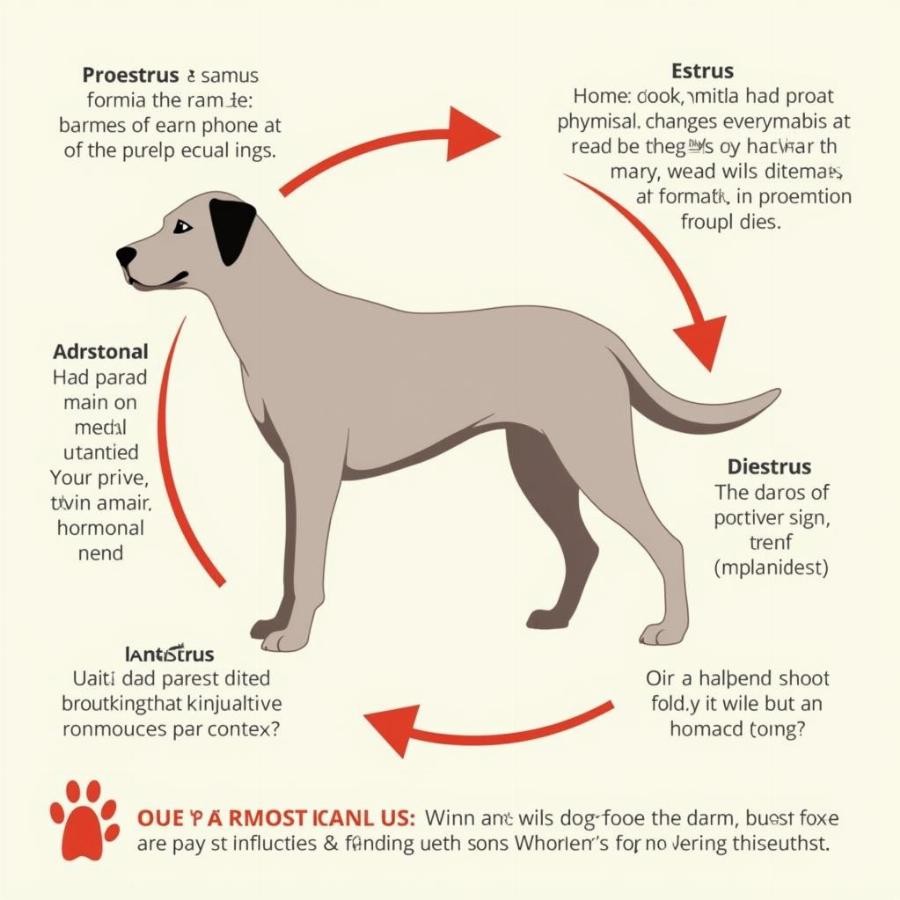Breeding dogs is a significant responsibility that requires careful consideration of the dog’s health and well-being. While some may wonder “how often can you breed a dog,” the focus should always be on responsible breeding practices rather than maximizing the frequency. Understanding the physical and emotional toll of pregnancy and birth on a female dog is paramount. This article will delve into the recommended breeding frequency, factors influencing breeding decisions, and the importance of prioritizing the health and welfare of your canine companion.
Understanding the Canine Reproductive Cycle
Before delving into breeding frequency, it’s essential to understand the canine reproductive cycle. Female dogs typically experience their first heat cycle between six and twelve months of age. The heat cycle, also known as estrus, lasts for about three weeks and occurs approximately every six months. During this period, the female is fertile and receptive to mating.
The Importance of Heat Cycles in Breeding
Heat cycles are a crucial indicator of a female dog’s reproductive health. Observing these cycles helps breeders determine the optimal time for breeding and avoid complications. Breeding too frequently can deplete the female’s resources and negatively impact her overall health.
 The Canine Reproductive Cycle
The Canine Reproductive Cycle
How Often Should You Breed a Dog?
While technically a female dog can go into heat twice a year, responsible breeders typically recommend breeding no more than once every 18-24 months. This allows the dog’s body ample time to recover from the physical demands of pregnancy and lactation. Frequent breeding can lead to health issues, including uterine infections, exhaustion, and weakened immune systems.
Factors Affecting Breeding Frequency
Several factors can influence the appropriate breeding frequency for a dog:
- Age: Younger and older dogs should be bred less frequently to minimize health risks.
- Breed: Certain breeds may have specific reproductive considerations.
- Overall Health: A dog with pre-existing health conditions should not be bred.
- Previous Litters: The size and frequency of previous litters can impact future breeding decisions.
Risks of Overbreeding
Overbreeding can have devastating consequences for both the mother and her puppies. Some of the risks include:
- Reduced Litter Quality: Puppies from overbred mothers may be smaller, weaker, and more susceptible to illness.
- Maternal Health Problems: Overbreeding can lead to uterine infections, dystocia (difficult birth), and even death.
- Behavioral Issues: Puppies from overbred mothers may exhibit behavioral problems due to inadequate care and socialization.
Prioritizing Dog Welfare in Breeding Decisions
Responsible breeders prioritize the well-being of their dogs above all else. This involves careful selection of breeding pairs, providing proper prenatal care, and ensuring that puppies are placed in loving homes.
Expert Insights on Responsible Breeding
Dr. Emily Carter, a renowned veterinarian specializing in canine reproduction, emphasizes the importance of responsible breeding practices: “Breeding dogs is a privilege, not a right. We must always prioritize the health and well-being of our canine companions and avoid overbreeding at all costs.”
mitt brush for dogs can be a great tool to maintain your dog’s coat during pregnancy.
Conclusion
The question of “how often can you breed a dog” should be reframed as “how often should you breed a dog.” Responsible breeding practices prioritize the health and welfare of the mother dog and ensure the quality of the litter. By understanding the canine reproductive cycle, considering the various factors affecting breeding frequency, and avoiding overbreeding, we can help ensure the long-term health and happiness of our canine companions.
FAQ
- What is the earliest age a dog can be bred? While dogs can go into heat as early as six months, it’s generally recommended to wait until they are at least two years old.
- How can I tell if my dog is ready to breed? Consult with your veterinarian to determine the optimal breeding time based on your dog’s age, breed, and health.
- What are the signs of overbreeding? Signs of overbreeding can include decreased litter size, weakened puppies, and health problems in the mother dog.
- How can I find a responsible breeder? Look for breeders who prioritize the health and well-being of their dogs, provide proper care for puppies, and are knowledgeable about the breed.
- What are the legal requirements for breeding dogs? Breeding regulations vary depending on your location. Check with your local authorities for specific requirements.
- What are the financial implications of breeding dogs? Breeding dogs can be expensive, involving costs for veterinary care, food, supplies, and potentially advertising and marketing.
- What are the ethical considerations of dog breeding? Ethical breeders prioritize the welfare of their dogs and contribute to the improvement of the breed, avoiding practices that compromise animal health or contribute to overpopulation.
large dog tent could be a useful tool if you have a lot of puppies to take care of.
Other questions and related articles available on our website
While we couldn’t find directly related articles on our site at this time, you might be interested in learning more about caring for pregnant dogs and puppies. We recommend checking back for updates soon.
pomeranian shih tzu dog is a great breed to own!
Beaut Dogs is your trusted source for all things related to dog breeding and care. We offer expert advice, helpful resources, and a community of passionate dog lovers. When you need support, contact us via Email: [email protected] to receive detailed and accurate answers from Beaut Dogs.
claw clippers for large dogs are essential for your dog’s hygiene.